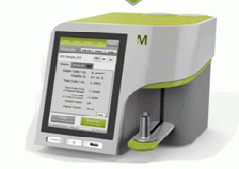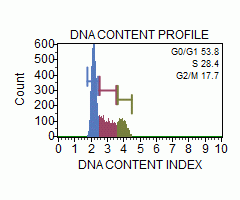- UV excited: Hoechst 33342, Hoechst 33258, DAPI
- 457nm excited: Mithramycin
- 488nm excited: Propidium Iodide, 7-Aminoactinomycin
- 532nm excited:Propidium Iodide
- D, SYTOX Green, DRAQ5
- 633nm excited: TO-PRO-3 Iodide
- Violet (405nm) excitation of Hoechst 33342
One important aspect of DNA analysis is the ability of the cytometer to exclude cell doublets. In a cytometer where the beam diameter is larger than the nuclear size, we can look at pulse width versus pulse area to exclude cell doublets - a true G2 cell will have a smaller width than two G1 cells passing through the beam together consecutively.
This technique is based on the premise that cells in G0 or G1 phases of the cell cycle possess a normal diploid chromosomal, and hence DNA content (2n) whereas cells in G2 and just prior to mitosis (M) contain exactly twice this amount (4n). As DNA is synthesized during S-phase, cells are found with a DNA content ranging between 2n and 4n. A histogram plot of DNA content against cell numbers gives the classical DNA profile for a proliferating cell culture.
- Protocol - PI staining
- Use of RNase with PI protocol
- Protocol - DAPI staining
- Protocol - 7-AAD staining


